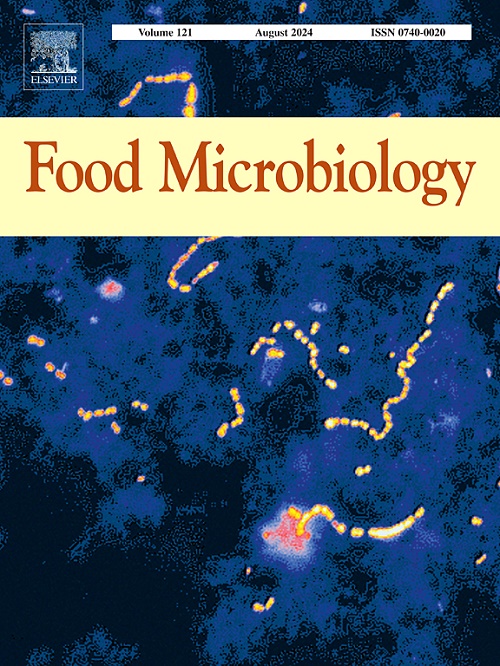Bacillus subtilis fermented shrimp waste isolated peptide, PVQ9, and its antimicrobial mechanism on four Gram-positive foodborne bacteria
IF 4.5
1区 农林科学
Q1 BIOTECHNOLOGY & APPLIED MICROBIOLOGY
引用次数: 0
Abstract
Bacillus subtilis produces proteases that hydrolyze proteins to produce bioactive peptides. Given the mounting waste from processed shrimp, the antimicrobial potential of peptides isolated from B. subtilis fermented shrimp waste was explored. Among the five peptides screened using molecular docking prediction, PVQ9 (AVFPSIVGRPR) had strong antibacterial activity against four common foodborne Gram-positive bacteria, i.e., Staphylococcus aureus, Bacillus cereus, Mammaliicoccus sciuri, and Kurthia gibsonii. The minimum bactericidal concentrations (MBCs) were 62.5 μg/mL for S. aureus and B. cereus, and 31.3 μg/mL for both M. sciuri and K. gibsonii, with a time-kill of 3 h observed for all strains. Mechanistically, it was demonstrated that PVQ9 could destroy bacterial cell walls, change bacteria cell membrane permeability, bind to bacteria DNA, and cause cell apoptosis. Most importantly, peptide PVQ9 could inhibit the spoilage of bean curd or tofu contaminated with K. gibsonii. These findings suggest that PVQ9 could be a useful preservative in controlling foodborne pathogenic bacteria in soy products and other processed foods.
枯草芽孢杆菌发酵虾粪分离肽 PVQ9 及其对四种革兰氏阳性食源性细菌的抗菌机制
枯草芽孢杆菌(Bacillus subtilis)能产生蛋白酶,水解蛋白质以产生具有生物活性的肽。鉴于加工虾类产生的废物越来越多,研究人员探索了从枯草芽孢杆菌发酵虾类废物中分离出的多肽的抗菌潜力。在利用分子对接预测筛选出的五种肽中,PVQ9(AVFPSIVGRPR)对四种常见的食源性革兰氏阳性菌,即金黄色葡萄球菌、蜡样芽孢杆菌、Mammaliicoccus sciuri和Kurthia gibsonii具有很强的抗菌活性。金黄色葡萄球菌和蜡样芽孢杆菌的最低杀菌浓度(MBCs)为 62.5 μg/mL,M. sciuri 和 K. gibsonii 的最低杀菌浓度(MBCs)为 31.3 μg/mL,所有菌株的杀菌时间均为 3 小时。从机理上讲,PVQ9 可以破坏细菌细胞壁、改变细菌细胞膜的通透性、与细菌 DNA 结合并导致细胞凋亡。最重要的是,肽 PVQ9 能抑制被吉布森氏酵母菌污染的豆腐或豆腐的腐败。这些研究结果表明,PVQ9 可以作为一种有用的防腐剂来控制豆制品和其他加工食品中的食源性致病菌。
本文章由计算机程序翻译,如有差异,请以英文原文为准。
求助全文
约1分钟内获得全文
求助全文
来源期刊

Food microbiology
工程技术-生物工程与应用微生物
CiteScore
11.30
自引率
3.80%
发文量
179
审稿时长
44 days
期刊介绍:
Food Microbiology publishes original research articles, short communications, review papers, letters, news items and book reviews dealing with all aspects of the microbiology of foods. The editors aim to publish manuscripts of the highest quality which are both relevant and applicable to the broad field covered by the journal. Studies must be novel, have a clear connection to food microbiology, and be of general interest to the international community of food microbiologists. The editors make every effort to ensure rapid and fair reviews, resulting in timely publication of accepted manuscripts.
 求助内容:
求助内容: 应助结果提醒方式:
应助结果提醒方式:


